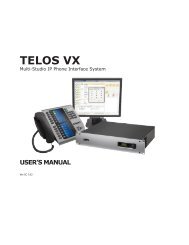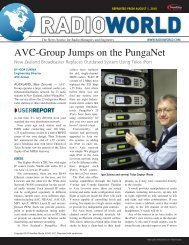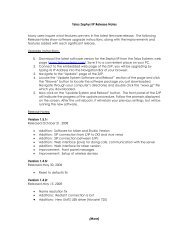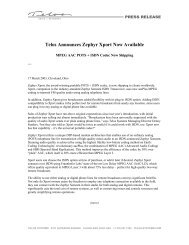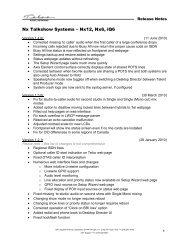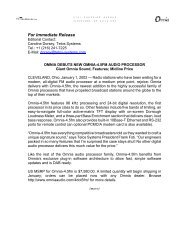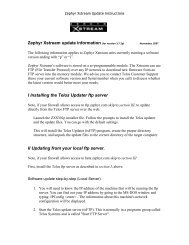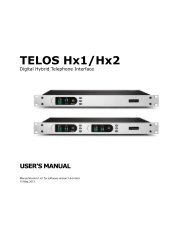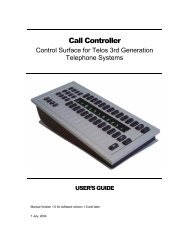NOW! 12-13 - Telos
NOW! 12-13 - Telos
NOW! 12-13 - Telos
Create successful ePaper yourself
Turn your PDF publications into a flip-book with our unique Google optimized e-Paper software.
OMNIA | FM-STEREO TRANSMISSION | TECHNOLOGY ARTICLE<br />
58<br />
SINGLE SIDEBAND SUPPRESSED CARRIER (SSBSC)<br />
REAL WORLD ACTIVITY: IN THE FIELD, AND IN THE LAB<br />
Transmitting SSBSC modulation of the FM-Stereo signal can be<br />
done right now! Software exists to implement this method to-<br />
day. One minor item must be addressed: FCC rule 73.322, section<br />
(A), subpart (4) which states “Double sideband, suppressed-car-<br />
rier, amplitude modulation of the stereophonic subcarrier at 38<br />
kHz must be used.” Seems there was a time, when rule 73.322(A)<br />
(4) was required. Times have changed. Both transmission and re-<br />
ception irmware have improved signiicantly to enable a change<br />
in the rules and regulations governing FM-Stereo, at least to al-<br />
low the use of SSBSC as an option for the broadcaster.<br />
At present, based on the theory, testing, and indings present-<br />
ed here, the FCC allows Experimental Authority (EA) operation,<br />
which enables broadcasters to implement the SSBSC transmis-<br />
sion method. Beneit occurs immediately to those whom employ<br />
SSBSC, especially those in areas of rough terrain with signii-<br />
cant hills, and mountains. As of this writing, SSBSC is on-the-<br />
air in multiple major markets, and all users report a reduction<br />
in perceived multipath. The general consensus is how a mobile<br />
receiver operates less in the blend function. As the radio comes<br />
out of blend, when SSBSC is used, the appearance of added high<br />
frequency content is perceived. Many radios reduce the high<br />
frequency range, along with blending stereo separation during<br />
instances of multipath. In some cases the change is quite notice-<br />
able, and in others it has been observed to be a small improve-<br />
ment. It should be noted that severe multipath will cause annoy-<br />
ance to either form of transmission: DSBSC and SSBSC.<br />
While most feedback is of the subjective anecdotal variety, there<br />
has been some initial lab testing done to determine, at the very<br />
least, if SSBSC offers any degradation to FM service. Using a mul-<br />
tipath generator, that offered repeatable multipath proiles in a<br />
controlled environment, it was possible to gather data from a re-<br />
ceiver operating under an impaired signal. Testing was done with<br />
DSBSC and repeated for SSBSC. A simple test of transmitting a<br />
1kHz tone in a single channel, and then monitoring the recovered<br />
Left/Right channels in a mobile receiver would indicate any deg-<br />
radation between DSBSC and SSBSC. The test was done over a<br />
twenty-four second period. Figure-21 illustrates the plot of the<br />
transmit 1kHz tone in the Left channel, along with any crosstalk<br />
that spilled over into the Right channel due to hits of multipath.<br />
The multipath instances can be observed as the sections of the<br />
Left channel where the signal degrades. Figure-22 is the result of<br />
the same test done in SSBSC mode.<br />
Figure-21, DSBSC<br />
Figure-22, SSBSC<br />
Notice there is virtually no difference between the two plots.<br />
Had multipath distortion been more severe for either mode,<br />
the amount of crosstalk into the Right channel would have in-<br />
creased. This test therefore indicates that SSBSC offers no per-<br />
ceivable degradation to the FM service signal.<br />
TAKING IT TO THE NEXT LEVEL…<br />
In addition to those broadcasters whom are using SSBSC under<br />
an EA from the FCC, there is continued testing being done in the<br />
lab. The topic is also an active action item within the AM FM Au-<br />
dio Broadcast (AFAB) sub-group of the National Radio Systems<br />
Committee (NRSC). As with any consideration to possibly change<br />
the rules, testing, data gathering, and system evaluation must<br />
be done. Additionally, viability must be shown to indicate public<br />
beneit.<br />
To this extent, criteria has been brought forward to propose<br />
tests which would help answer questions regarding the feasibil-<br />
ity of SSBSC as an optional transmission method to the present<br />
means. What follows is the body from a paper offered by John<br />
Kean, of NPR Labs.<br />
“Conversion to a single-sideband suppressed carrier stereo sub-<br />
channel for FM broadcasting represents a technical change in<br />
terms of FCC rules that is suficient to require thorough docu-<br />
mentation in the public record. Indeed, comments iled recently<br />
with the NRSC suggest that while a SSBSC system may offer<br />
beneits, such as reduced noise and interference to IBOC digital<br />
sidebands, the system also may increase FM audio distortion un-<br />
der multipath reception conditions [2][3]. These potential issues<br />
should be evaluated objectively and made available to the radio<br />
industry through the NRSC. This paper discusses a suggested ap-<br />
proach for tests that can determine the compatibility of SSBSC,<br />
as well as potential improvements offered by SSBSC.<br />
Evaluation of a new transmission standard may be considered in<br />
three main areas:<br />
» Receiving compatibility with the host station’s signal<br />
» Potential for reception enhancements<br />
» Effect on stations on adjacent frequencies<br />
(allocation compatibility)<br />
The irst area, compatibility with the host, may be considered for<br />
the following:




